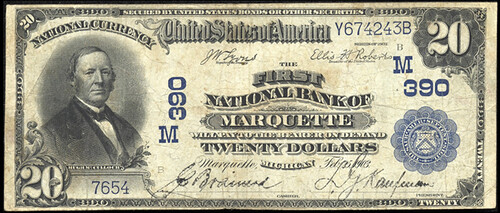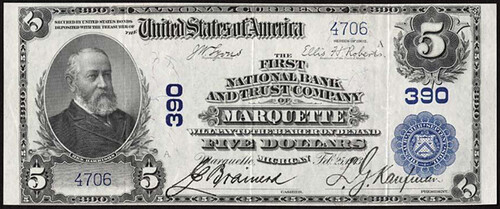
PREV ARTICLE
NEXT ARTICLE
FULL ISSUE
PREV FULL ISSUE
L. G. KAUFMAN’S NUMISMATIC LEGACY
Peter Huntoon submitted this article about other banknotes with the signature of L. B. Kaufman, who is also known to numismatists for his Dollars of the World coin exhibit. Thanks!
-Editor
Reader Leon Saryan nicely pointed out that the signature of renowned collector L.G. Kaufman appeared as president on the national bank notes issued by the Chatham Phenix National Bank of New York, and he provided a nice example from the Series of 1902. They also appear on the 1929 notes issued from the bank. Kaufman’s signature also appears on his home town Marquette, Michigan, notes where they were current from 1908 through the end of the national bank note era in 1935. The First National Bank of Marquette adopted trust powers in 1925, so his signature transcends the title change to The First National Bank and Trust Company. I am attaching examples of his Margette notes to round out your tale concerning his concurrent Michigan and New York presidencies.



Series of 1902 and 1929 notes issued with the two titles of Kaufman’s Margette bank. The Chatham Phenix side of the story involves a totally unique occurrence that resulted from a mistake that was costly to the bank. National bank legislation was amended in 1920 to allow the use of signatures engraved directly on the printing plates at the Bureau of Engraving and Printing as a concession to bankers who were getting tired of having to either sign or rubber stamp their signatures on their notes or have them overprinted by local contractors. This was a Godsend for large banks such as the Chatham Phenix. There was a $22 one-time charge to the banks to have the bank signatures added to each existing plate combination used to print the notes for the bank. Of course, the officers of the Chatham Phenix bank jumped at the change and requested that their signatures be added to their plates. But things did not go smoothly. One of the clerks in the Comptroller’s office, at the request of the officers of the bank, placed an order with the Bureau to add engraved signatures to their 5-5-5-5 and 10-10-10-20 plates. The order was logged in at the Bureau July 26, 1926, and included charges to the bank of $284 ($120 per plate and $22 per added pair of signatures). It is clear that the Bureau clerk was logging in charges for both plates and engraved signatures, but the work order specified only signatures. A note in a plate history ledger maintained by the Bureau states that the order was canceled August 12th, the reason being that the existing plates were worn, and replacements would be ordered shortly. The Comptroller’s office submitted a second order on August 16, this one for the needed replacement plates. However, by then, the first order for signatures had been canceled, so no work was undertaken, and the plate order was rejected. Replacement plates were again ordered on August 23-24, but this order failed to include the signatures. The Bureau executed this order. Soon, as the bankers began receiving their sheets, they discovered their notes still didn’t have signatures. The solution settled upon was to overprint the darn things at the Bureau. This is the only time this service was ever extended to any bank in the entire country. The overprinting plate was ordered at a cost of $40, and put into service during December 1926. In time two additional overprinting plates were needed before the close of the Series of 1902 in 1929. The Chatham Phenix bank was billed an extra $2,593.85 for the honor of being the only bank in the country to utilize Bureau overprinted signatures between 1926 and 1929. These charges were calculated at $4 per 1,000 sheets, plus the costs for the plates, respectively $2,473.85 plus $120. Had the initial July 26, 1926 request to add engraved signatures to the existing but worn plates been executed, the bank would have incurred a one-time charge of $22 per plate, $44 total, and been done with the matter. Three signature overprinting plates were made at the BEP for the bank, the second and third being identical. Notes from the two BEP varieties are shown, along with a note with signatures overprinted by a private contractor prior to BEP involvement. Kaufman’s signature is particularly large on the contractor notes. Q. David Bowers supplied the following information. "Louis Kaufman, and his brother Nathan, born in Marquette, were serious, accomplished coin collectors. When Nathan died in 1918, Louis consolidated the collections into one, and named it the Nathan M. Kaufman collection. The collection was renowned for rare Colonial coins and U. S. and private territorial gold coins. Louis placed it on exhibit in the Chatham-Phenix bank in New York. When he returned to Marquette to build a new bank building, he had special wall safes and display cases built to display it. The collection was moved there where it remained for decades. Louis died in 1942." I found it particularly ironic that Louis Kaufman, the consummate numismatist, happened to be center stage in the production of a totally unique numismatic variety involving the overprinting of his signature on 1902 series Chatham Phenix issues by the BEP. He had no idea that this distinction had befallen him, and it is doubtful that he included examples of the notes with his signature in his coin collection on display at either the New York or Margette banks because at the time national bank notes simply were ordinary objects of little interest to numismatics! Little did Kaufman know that someday avid currency collectors would discover this odd tale and avidly chase the notes signed by him, and cherish them as much as he cherished his gold coins.

The Chatham Phenix National Bank and Trust Company was the only bank to utilize bank signatures on large size notes that were overprinted at the Bureau of Engraving and Printing. Top note: early signatures overprinted by a private contractor. Middle note: signatures from the first signature overprinting plate made at the BEP. Bottom note: signatures from the second overprinting plate made at the BEP. The signatures on the third BEP overprinting plate were the same as on the second.

Kaufman’s signature was current on the notes from the Chatham Phenix bank from 1910 until 1932 when the bank was liquidated. The photos used here are courtesy of the Heritage Auction Archives (HA.com) and the National Currency Foundation (nbncensus.com).
Interesting connection with Louis and his brother Nathan Kaufman's collections. I don't think I'd heard of Louis' collection before, and hadn't made the connection with Nathan Kaufman. Numismatics is a small world. Many thanks to Peter for providing this wonderful illustrated article.
-Editor
To read the earlier E-Sylum article, see:
L. G. KAUFMAN'S BANKNOTE SIGNATURE
(www.coinbooks.org/esylum_v16n35a21.html)
The Numismatic Bibliomania Society is a non-profit organization promoting numismatic literature. See our web site at coinbooks.org. To submit items for publication in The E-Sylum, write to the Editor at this address: whomren@gmail.com To subscribe go to: https://my.binhost.com/lists/listinfo/esylum All Rights Reserved. NBS Home Page Contact the NBS webmaster 
|